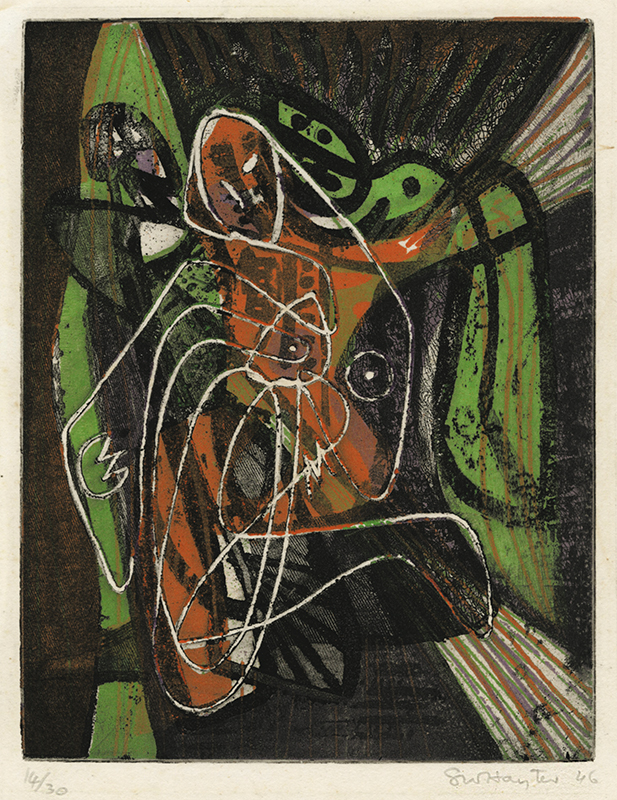Palimpsest is an intaglio created in 1946 by the influential English-born printmaker, Stanley William Hayter. The medium is a combination of sugar-lift, soft-ground etching, and scorper and the colors, green, cadmium orange, and red-violet, were applied using three silkscreens. Palimpsest is pencil signed, dated, and editioned 14/30. It was printed by the artist at Atelier 17 in New York on ivory laid Japanese Kochi paper. The reference for Palimpsest is Black and Moorhead 170 and the platemark measures 9 x 7 inches.
Palimpsest was created on a zinc plate in three states: the first state began in October 1945 when the plate was worked with sugar-lift and soft-ground, and then soft ground texture was added; for the second state of the plate the textures were rebitten on 15 March 1946; and then for the third and final state of 17 March 1946, Hayter used a scorper to achieve the three-dimensional elements.
In literary terms, a 'palimpsest' is a manuscript or piece of writing material on which the original writing has been effaced to make room for later writing but of which traces remain. In art terms it can also describe a work of art that has many levels of meaning, types of style, etc. that build on each other. This is certainly the case for Hayter’s intaglio as he built layers of lines, colors, textures, and shapes overlapping each other. He used a dimensional white line, gouged out with a scorper, to create an abstracted figure on the surface of the colors.
Stanley William Hayter was born in Hackney, England on 27 December 1901. After three years working as a chemist in the oil fields of Iran, he enrolled in the Académie Julian in Paris in 1926. There he met the engraver Joseph Hecht and began to merge chemistry with printmaking. In 1927, Hayter founded Atelier 17, an experimental graphic arts workshop in Paris that played a central role in the revival of the print as an independent art form. European artists came to work with him and ideas flowed freely. Hayter left Paris in late 1939 as war closed in on the city.
Hayter opened Atelier 17 in 1940 in New York and the studio became a melting pot of European artists who had fled the war and American artists, many who had worked in the printmaking section of the WPA. The emphasis was on experimental color printing, including the use of viscosity printing and offset color using screenprint, stencil, and woodcut.
Hayter returned to Paris in 1950 and reopened Atelier 17, attracting many artists from Asia. He continued to experiment with color printing, including the use of Flowmaster pens, incongruous and fluorescent colors, and flowing, interwoven patterns. With an unrivaled knowledge of the technicalities of printmaking, Hayter authored two major books, New Ways of Gravure and About Prints.
The works of Stanley William Hayter are represented in the collections of the Brooklyn Museum, New York; the Albright-Knox Art Gallery, Buffalo, New York; the Harvard Art Museums, Cambridge, Massachusetts; the Cleveland Museum of Art, Ohio; the Flint Institute of Arts, Michigan; the Museum of Fine Arts, Houston, Texas; the Indianapolis Museum of Art, Indiana; the Israel Museum, Jerusalem; the British Museum and the Tate, London; the Metropolitan Museum of Art, the Museum of Modern Art, the Whitney Museum of American Art, New York; the Woodmere Art Museum, Philadelphia; the Fine Arts Museums of San Francisco, California; and the National Gallery of Art and the Smithsonian American Art Museum, Washington, D.C.
Stanley William Hayter died in Paris on 4 May 1988.



